
A new book on natural beekeeping, written by Temi Odurinde was made available for sale on Amazon on the 13th of June 2021. Titled A beginner’s guide to natural beekeeping, the book takes a complete beginner through all the steps they need to take to start keeping honey bees, using natural beekeeping methods.
The first two chapters of the book saw Temi draw on his background as a sustainability advocate, to urge people who are thinking of keeping bees but have doubts to get started and put their doubts to one side.
For those whose concern is about cost, he demonstrates how they can start beekeeping on a shoestring budget. For those who are not sure about the benefits of keeping bees, he put forward an environmental argument, including how keeping bees help promote biodiversity and the additional benefits which includes helping other pollinator insects.
In subsequent chapters, the book goes on to take a beekeeper to be, on a step-by-step guide preparation for starting beekeeping. Beekeeping equipment such as beehives, beekeeping suits and other materials. The chapter on beekeeping equipment was followed by how to acquire your first swarm of bees.
Though the primary reason natural beekeepers keep bees is not to harvest honey, when a hive has excess honey, some natural beekeepers do harvest the honey. A beginner guide to natural beekeeping delved into how and when to take honey, should the beekeeper want to do so. A lot of emphasis is placed on ensuring that the bees are left with enough of their own honey to eat. The practice of feeding bees with sugar water, when all their honey is taken away is strongly discouraged.
There were chapters on caring for your bees. The book takes the view that in the first instance, to have a strong colony of bees, the beekeeper should source their swarm locally. This will ensure that the bees are able to cope with the local environment and pest. The caring for your bee section expanded into winter care, which is the time of the year the bees need help the most. Everything a beekeeper need to do to see his hives though the winter is explained.
The later chapters of the book looked into harvesting and using hive products such as wax and propolis. Some tried and tested recipes for making food, beauty products beeswax candles and other products is discussed
One of the stand out chapters in the book is a rather contradictory sounding chapter called beekeeping without keeping bees. In this chapter, Temi explains how you may still help bees even if you decide not to go ahead with keeping bees. He explained the plants bees feed on and urgest gardeners who decided not to keep bees to plant more of such plants. Mowing our lawn less often is another bee friendly habit the book suggested for beekeepers and non-beekeepers alike.
You can order A beginner’s guide to natural beekeeping on Amazon.
A Beginner’s Guide to Natural Beekeeping – second editon notes
- A clear definition of what natural beekeeping mean.
- Expansion of the section on planting for bees, with notes on plants/flowers that are bee-friendly and flowers/bedding plants that are not helpful to bees.
- A chapter on bumblebees.
The picture below was taken by Stephen Abbott, it shows bees making combs their way, unconstrained by the “foundation” non natural beekeepers tend to use in man made beehives. Thank you Stephen for giving me the permission to use your lovely picture.

- Mouse Guards – What size hole will keep mice out of your hive? holes of 9.5mm or 8mm.
- Keeping hive products near your Apiary – According to Steve Utely, this could result in the following: Any bee products shouldn’t be left close to the apiary, as this ‘frenzy’ of finding it, could cause robbing within the apiary. Anything close to the apiary, the bees use the round dance, this dance doesn’t give direction, therefore the bees fly out in all directions to smell the ‘goodies’, this could get them smelling honey in other hives and going for that instead, if the receiving colony is not strong enough, they will be overwhelmed.
